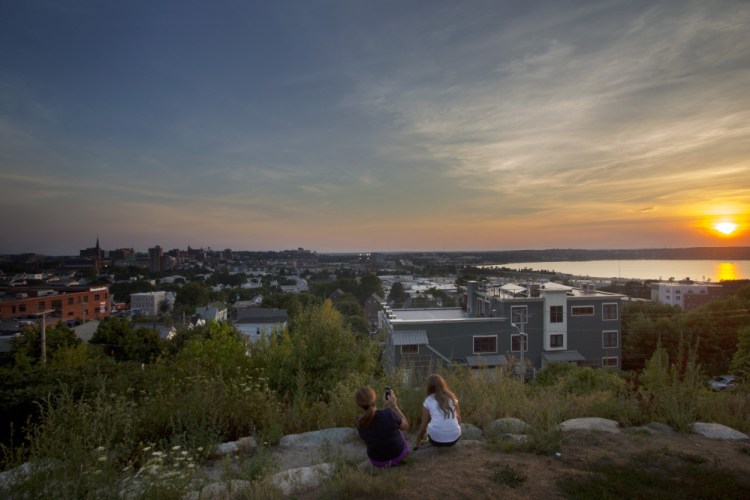Munjoy Hill residents are working on multiple fronts to protect the sweeping view of the city from Fort Sumner Park on North Street that could be obstructed by a planned condo building.
On Monday, residents delivered two petitions to the City Council asking it to ensure a planned development on Sheridan Street would not have an adverse effect on the view. One of the petitions, submitted by Carolyn Young, had almost 300 signatures, according to the Facebook group Save Fort Sumner Park.
On Wednesday night, activists asked the city’s historic preservation board to start the process of designating the park a local landmark. A designation would require the Planning Board to consider the impact of proposed development on the park’s historic characteristics, namely the view.
David Cowie, who lives about a block away from the park on North Street, said residents will use any means possible to prevent construction that would block the park vista.
“It’s a full court press to try and get the development in the city to be limited in terms of some of these important landmarks,” Cowie said.
“There is something not right in workings of city hall when a group of citizens has to take the steps we have had to take to simply preserve what is an integral part of our neighborhood,” Cowie said.
People are worried that a six-story condo complex at 155 Sheridan St., below the park’s steep bank, floated by developer Bernie Saulnier will block part of the view over Back Cove and into the western foothills and Mount Washington. In an interview last week, Saulnier said no plans have been submitted to the city and his company is changing the design so it will not block the view.
In a presentation to the preservation board, Cowie and Willis Street resident Nini McManamy said the park has been an important part of the neighborhood since the 18th century, first as a fortification, then for recreation. Local historians Herb Adams and Ken Thompson presented a history of the fort to the board.
An earth and timber citadel was built on the site of the park in 1794 as part of the first federal coastal defense system. It was a recruiting station for the War of 1812, but was decommissioned and eventually torn down. Portland acquired the property in 1890 and it was listed as a city park in 1934, according to research done by the group. The park’s vista has been its most important characteristic throughout its history, first for soldiers to keep watch for an approaching enemy, and later as a treasured public resource and a place for quiet reflection, Cowie said.
But getting a designation for the park might not be straightforward. Most of Portland’s individual landmarks are buildings and a number of neighborhoods, like the Old Port, are local historic districts. Public parks like the Eastern and Western proms and Deering Oaks are on the National Register of Historic Places.
But Fort Sumner Park is a “different animal,” said Deb Andrews, manager of Portland’s historic preservation program. It was likely passed over when other parks were put on the national register in the late 1980s because it didn’t have the same type of designed landscape, or was simply overlooked.
“It was probably omitted for a variety of reasons,” she said.
To move the process forward, at least two board members have to formally nominate the park for landmark designation. Then, it will need to make sure the park meets the city’s requirements for landmark status before making a recommendation to the City Council.
If the park is given landmark designation, the Planning Board would have to consider how its character would be affected by proposed development within 100 feet, Andrews added.
Landmark designation could be complicated since no evidence of the fort remains. It’s not even clear exactly where it was located and no archaeological work has been undertaken. In order to recommend landmark status, the preservation board has to determine if the property is historically significant, but also if it has sufficient integrity to make it worthy of preservation or restoration.
Board member John Turk questioned whether the board would need to turn to its possible archaeological value as a basis for the integrity of the site. If petitioners think the site’s long history as a public space is also part of its historic significance, then the board would have to determine why the city purchased it in the 19th century, said board member Ted Oldham. It would be interesting to find out if it was bought to be a park, or as part of the land for the adjacent Shailer School, he said.
Cowie acknowledged the site had its complications, but hoped board members would still nominate it and work with residents to prove its historic importance.
“It is unfortunate that the evidence has vanished, but the boundaries of the fort are were the park is now, and I don’t think it would be a stretch for anyone to nominate the park for what it used to be,” Cowie said.
Correction: This story was revised at 10:38 a.m., Sept. 22, 2016, to correct the spelling of Shailer School.
Send questions/comments to the editors.




Success. Please wait for the page to reload. If the page does not reload within 5 seconds, please refresh the page.
Enter your email and password to access comments.
Hi, to comment on stories you must . This profile is in addition to your subscription and website login.
Already have a commenting profile? .
Invalid username/password.
Please check your email to confirm and complete your registration.
Only subscribers are eligible to post comments. Please subscribe or login first for digital access. Here’s why.
Use the form below to reset your password. When you've submitted your account email, we will send an email with a reset code.